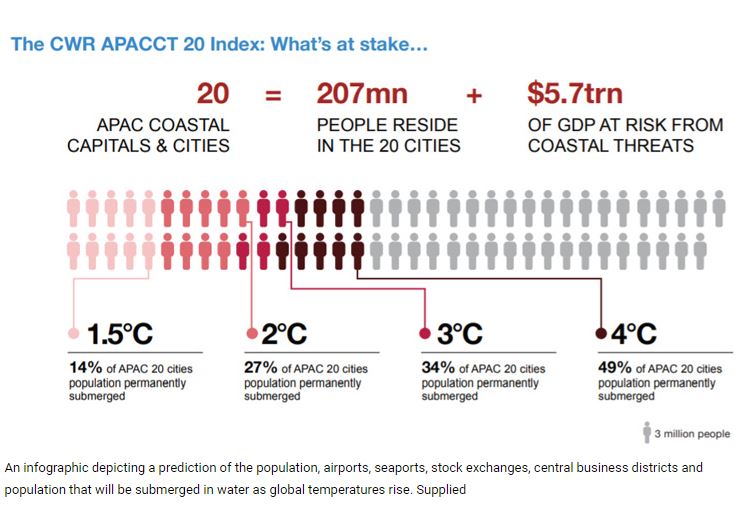Cambodia: Regional trade and economic hubs face risk of rising sea levels
In its “Avoiding Atlantis” report, Hong Kong nonprofit initiative China Water Risk (CWR) is calling for “bankers to be heroes” as rising sea levels threaten trade in the Asia-Pacific (APAC) region.
“Besides Beijing, Kuala Lumpur, Vientiane and Phnom Penh, all other APAC capitals are coastal, as are other economic hubs… The region is heavily reliant on trade and export-led growth, yet the linked RCEP [Regional Comprehensive Economic Partnership] trade deal could be at risk unless all parties in the region commit to and fast-track carbon neutrality,” the report said.
CWR seeks to help investors and businesses understand and mitigate risk around water-related issues. RCEP is a free trade agreement between the Asia-Pacific nations of Australia, Brunei, Cambodia, China, Indonesia, Japan, Laos, Malaysia, Myanmar, New Zealand, the Philippines, Singapore, South Korea, Thailand, and Vietnam.
CWR’s Water Risk Valuation Lead, Dharisha Mirando, told Bloomberg Markets Asia that 20 APAC cities risk being submerged – affecting four central business districts and 28 million people.
CWR lists Seoul, Ho Chi Minh City, Bangkok, Macao and Taipei as the least prepared for sea-level rises. Singapore, Jakarta, Shenzen, Shanghai and Auckland are considered best prepared.
EnergyLab Cambodia Country Director Bridget McIntosh told Khmer Times that Sihanoukville is also at risk as sea levels rise.
Mirando said CWR reached out to more than 100 financial experts when drafting its report. It found that urban real estate, equivalent to the size of 59 Singapores, will be under water without serious adaptation measures being achived by at least 2100.
“Even if your cities are not at the coast, your trade infrastructure would be affected. We need to think about where you invest, how you can adapt your investment portfolios and how can you adapt to this new future. Clean energy and tech will reach at least $16 trillion in investments by 2030,” Mirando said.
McIntosh said bankers are taking a leading role to mitigate a climate-related disaster by encouraging paradigm shifts in energy production.
She said key investors in Cambodia, including Adidas, H&M and VH Corp have their own renewable energy targets and together make up more than 30 percent of all Cambodia garment exports which equates to more than $2 billion. Adidas alone employs more than 80,000 Cambodians.
McIntosh ponted out that while many bankers and governments are moving away from financing coal, China remains a key funder of coal projects.
She called for a policy that requires competitive bidding for all electricity projects including for coal, gas, solar and wind initiatives, which she said would “result in more solar and wind [power] because they produce electricity at lower prices”.
“Cambodia could easily remain at 50 percent renewable energy until 2030 and 2040 – with 15 percent generation from solar and wind by 2030 [increasing to] 30 percent by 2040,” she added.
A report published last year by the National Council for Sustainable Development and the Ministry of Environment said that Cambodia was “particularly vulnerable to the impacts of climate change”.
“Climate change may reduce the country’s annual GDP [gross domestic product] growth by 6.6 percent and absolute GDP by 0.4 percent in 2020, by 2.5 percent in 2030 and up to 9.8 percent in 2050. This may delay reaching middle-income status by one year,” the report said.
Source: https://www.khmertimeskh.com/820599/regional-trade-and-economic-hubs-face-risk-of-rising-sea-levels/


 English
English




